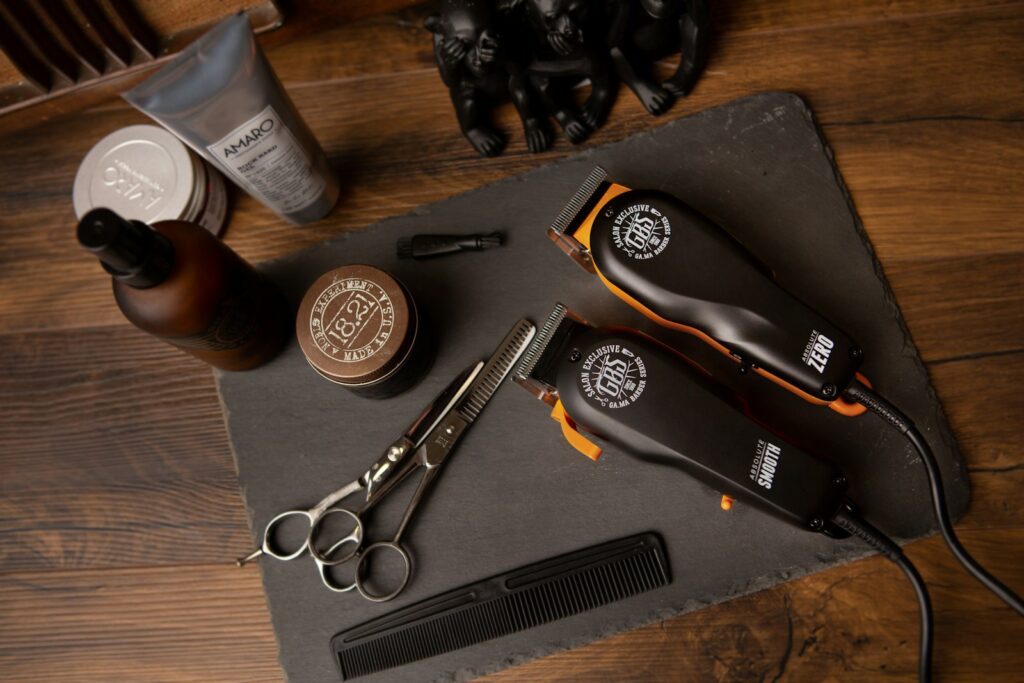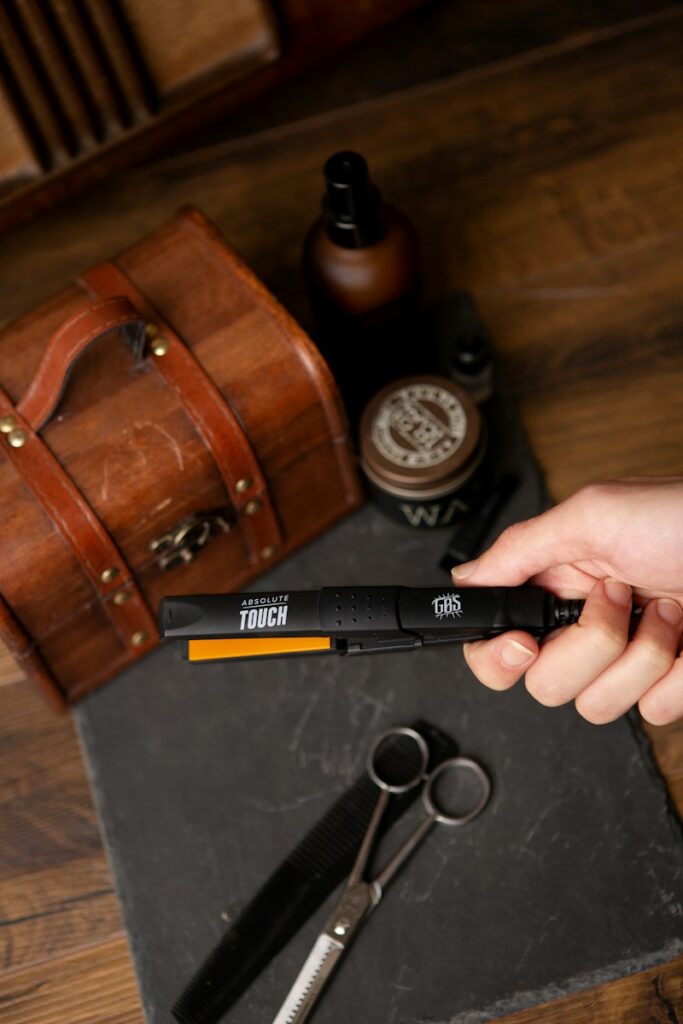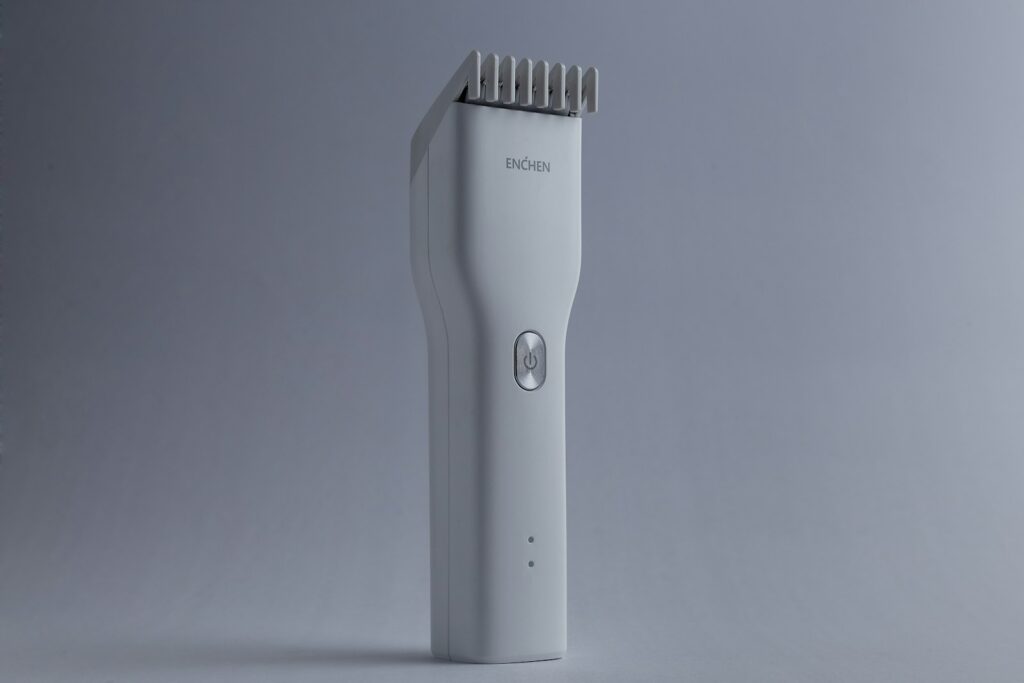Deciding between a beard brush and comb hinges on understanding your beard’s unique characteristics and grooming goals. While a brush excels at distributing natural oils and taming thicker, unruly facial hair, a comb offers precision in shaping and detangling. Both tools serve distinct purposes, enhancing one’s grooming routine. But how does one choose the right tool for their specific needs? This exploration will guide you through the subtleties, ensuring your beard achieves its fullest potential.
Key Takeaways
- Beard brushes excel in distributing natural oils and reducing frizz for healthier beard maintenance.
- Combs provide precise styling and detangling, especially useful for thick or coarse beards.
- Natural bristles offer gentle care and enhance beard health, while synthetic bristles are budget-friendly and vegan.
- Choose wide-toothed combs for thick beards and narrow-toothed for finer hair to prevent damage.
- Consider material preferences: wood and ox horn are durable and static-free; synthetics are affordable.
Understanding Beard Grooming Tools
Understanding beard grooming tools is vital for anyone looking to maintain a neat and healthy beard. These instruments, such as brushes and combs, play essential roles in personal grooming routines. Brushes, with their natural or synthetic bristles, distribute oils and condition beard hair, enhancing its appearance and health. They’re particularly beneficial for reducing dryness and itchiness, promoting a fuller look through regular use. Combs, on the other hand, are ideal for detangling and styling, especially for longer beards. They help in directing hair in desired ways, preventing knots. Regular cleaning is essential for tool longevity and effectiveness, ensuring your grooming tools perform at their best. Perfecting these tools guarantees a well-groomed beard that serves others confidently.
Components and Materials of Beard Brushes
In the pursuit of a well-groomed beard, it’s important to examine the components and materials that make up beard brushes. A typical beard brush comprises bristles and a body, often crafted from wood, bamboo, ox horn, or synthetic materials like plastic and cellulose acetate.
Wooden and bamboo bodies are eco-friendly and durable, while ox horn offers a traditional, static-free experience. Synthetic options are budget-friendly and vegan, though they may lack the natural benefits.
Bristles, commonly made from boar or horse hair, distribute oils effectively, promoting beard health. Each material choice serves different needs, ensuring a customized grooming experience. For those interested in all-natural beard care, 100% natural ingredients in products like beard oils can complement the grooming routine.
Key Features of Beard Combs
When choosing a beard comb, several key features stand out, guaranteeing effective grooming. The material is vital; wooden or ox horn combs are durable and often static-free, while plastic options might cause static or snagging.
Tooth size matters too: wider teeth work well for thick, coarse beards, while narrower teeth suit finer, softer hair.
Hand-cut teeth offer smoothness and quality, preventing damage better than stamped alternatives.
Lightweight and portable, beard combs are ideal for on-the-go grooming.
Ergonomic design enhances ease of use, providing comfort and control.
Selecting the right comb guarantees a well-maintained, stylish beard, reflecting care and attention.
Comparing Natural and Synthetic Bristles
As one considers the choice of grooming tools, exploring the differences between natural and synthetic bristles provides insightful perspective into their effectiveness and impact on beard health.
Natural bristles, such as boar and horse hair, excel in distributing sebum, conditioning beard hair, and reducing frizz, promoting a healthier beard. They’re gentle on the skin and enhance the grooming experience by minimizing breakage.
On the other hand, synthetic bristles, made from plastic or cellulose acetate, are vegan-friendly and more affordable but may cause static and breakage.
Understanding these differences helps individuals select the best option for enhancing beard care routines.
Selecting the Right Tooth Size for Your Beard
Choosing the right tooth size for a beard comb is essential for effective grooming and maintaining beard health. Wide-toothed combs are ideal for those with thick, coarse beards, as they ease detangling without snagging or causing breakage. They help distribute beard oils evenly, keeping the beard hydrated and smooth.
Narrow-toothed combs work best for fine, soft beard hair, allowing for precise styling and shaping. Selecting the appropriate tooth size ensures that grooming is both efficient and gentle, preventing damage.
Ergonomic Design and Portability Considerations
Ergonomic design and portability are essential factors when selecting grooming tools like beard brushes and combs. A well-designed tool fits comfortably in the hand, ensuring precise control during grooming. Lightweight materials enhance portability, making it easier to serve others by maintaining a polished appearance on the go.
Beard brushes, often larger and bulkier, may suit those with established grooming routines. In contrast, combs are slender and pocket-friendly, ideal for traveling. The choice between these tools depends on individual needs, considering how ease of handling and transportability affect daily grooming practices.
Thoughtful selection enhances both effectiveness and convenience.
Optimal Uses and Benefits of Brushes
When exploring the essential uses and benefits of beard brushes, it’s clear that these tools play a crucial role in maintaining a healthy beard. A beard brush offers numerous advantages for those who wish to serve others by keeping their beards well-groomed:
- Conditioning and Cleaning: Brushes distribute natural oils evenly, promoting softness and shine.
- Reducing Dryness and Itchiness: Regular use helps alleviate beardruff and discomfort.
- Stimulating Blood Flow: Enhances circulation to follicles, encouraging healthy growth.
- Training Beard Hairs: Helps achieve a fuller, more controlled look.
Embracing these benefits guarantees a beard that’s both attractive and manageable.
Effective Styling With Beard Combs
Having examined the numerous benefits of beard brushes, it’s important to understand how beard combs enhance grooming routines, especially for effective styling.
Beard combs are essential for detangling and guiding hairs into neat, desired shapes. They work well with beard oil, guaranteeing even distribution and reducing frizz.
For thicker, longer beards, wide-tooth combs are ideal, preventing knots while maintaining hair health.
Hand-crafted wooden or cellulose acetate combs offer durability and smoothness, serving users who prioritize quality.
Maintenance Tips for Longevity
To guarantee grooming tools last for years and remain effective, regular maintenance is essential. Proper care ensures they continue serving others by keeping beards looking their best.
Key maintenance tasks include:
- Cleaning Regularly: Wash brushes and combs gently using mild soap and water to remove dirt and oil buildup.
- Avoiding Moisture: Keep wooden tools dry to prevent warping and preserve their integrity.
- Storing Correctly: Store in a dry, ventilated area to prevent mold or deterioration.
- Handling With Care: Avoid dropping or exposing tools to harsh environments to maintain their condition.
Buying Guide for Quality Beard Tools
For those looking to invest in quality beard tools, understanding key factors can make a significant difference in the grooming experience. Consider the material, size, and bristle or tooth type when choosing a brush or comb. Wood and ox horn offer durability and static-free grooming, while synthetic options are budget-friendly.
| Factor | Recommendation |
|---|---|
| Material | Wood or Ox Horn |
| Comb Teeth Size | Wide for longer beards |
| Brush Bristles | Natural for oil distribution |
Choose larger brushes for thicker beards and travel-friendly sizes for convenience. Regular maintenance, like cleaning and gentle handling, prolongs tool lifespan and effectiveness.
Final Thoughts
Choosing between a beard brush and comb ultimately depends on the individual’s beard type and grooming needs. Brushes with natural bristles like boar or horsehair are excellent for distributing oils and softening thick, coarse beards. Combs with wider teeth are ideal for detangling and shaping finer or softer facial hair. Both tools play essential roles in a grooming routine, enhancing beard care. By understanding each tool’s benefits, users can maintain a well-groomed, healthy beard with ease.







